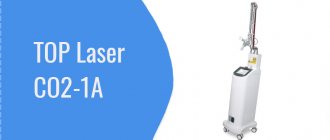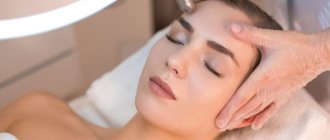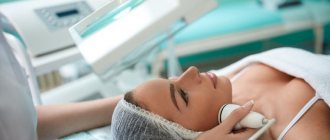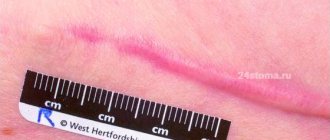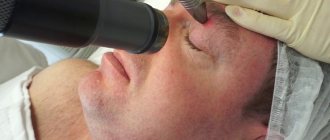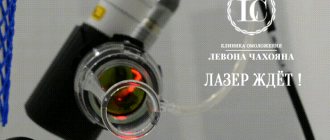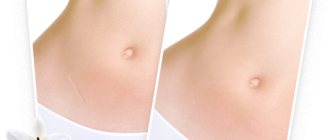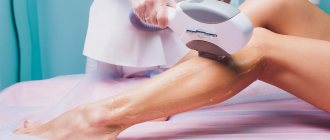Laser rejuvenation can be considered one of the most effective and universal methods of combating age-related skin changes. Targets (target chromophores) for laser radiation are almost all skin chromophores - water, hemoglobin, melanin, collagen. The selectivity of laser exposure allows you to select an individual scheme for correcting involutional skin disorders for any type of aging. Skin rejuvenation using a laser resurfacing device is achieved either by layer-by-layer removal - the ablation method, or by heating the skin without violating its integrity - the non-ablative method. In this case, the beam of the laser resurfacing device can be distributed on the skin in two ways: • by completely covering its surface (with classical ablation, non-ablative photothermolysis); • by crushing (fractionation) the laser beam into several tens or hundreds of microbeams (with fractional non-ablative photothermolysis, fractional ablation).
Do you urgently need to buy an UltraPulse device? Call us 8 (495) 988-21-80!
The mechanisms of skin rejuvenation when using ablative and non-ablative laser methods are different. In this article we will focus on the features of the use of ablative lasers.
CO2 laser rejuvenation “AcuPulse” - the result is obvious!
Today, aesthetic medicine experts call the fractional CO2 laser on the AcuPulse platform the most effective anti-aging set of measures that science has in its arsenal today.
The CO2 laser is all-round effective. It triggers natural processes in the body, initiating the production of elastin and collagen, which are responsible for tissue rejuvenation. This leads to complete renewal of the skin and obtaining a pronounced and lasting result.
Patients who have undergone the CO2 laser rejuvenation procedure can expect to smooth out wrinkles, eliminate the effect of enlarged pores, return the face to an even and fresh color, and increase the firmness and elasticity of the skin. Patients praise the laser for its powerful lifting effect and tightening of facial contours.
The popular technology is a procedure during which the inner layers of the patient’s skin are exposed to a carbon dioxide fractional laser. The principle of laser operation is as follows: a beam is formed, broken into small microbeams that penetrate into the deep layers of the skin. This ensures high safety of the procedure and rapid tissue healing.
CO2 laser rejuvenation is characterized by the following advantages:
- obtaining a pronounced result;
- recovery in 10-14 days;
- high degree of safety (compliance with FDA certificates);
- operative implementation of the procedure.
UltraPulse - ultrapulse fractional CO2 laser
UltraPulse is the most powerful of all CO2 lasers for aesthetic medicine.
Thanks to the unique ultra-pulse mode, it is able to solve the most complex problems in rejuvenating and smoothing the skin texture. UltraPulse allows you to penetrate the skin to a depth of up to 4 mm without stacking, which is important for the treatment of scars, at the same time, this laser is convenient to use for the most delicate resurfacing procedures with short rehabilitation. More details about the device
Who is the procedure indicated for?
Among the patients interested in CO2 laser rejuvenation using the AcuPulse device, there are mainly women over 37 years old, who have begun to noticeably show signs of aging. The technology is especially popular among both women and men who have problems in the area around the eyes. This method helps to almost completely remove microwrinkles and the notorious “crow’s feet” on these delicate areas of the skin.
AcuPulse is also in demand among women after pregnancy who want to get rid of unsightly stretch marks, as well as among people with unaesthetic scars, consequences of burns, injuries and surgical interventions.
The procedure gives the most striking results in the presence of the following problems:
- a large number of wrinkles (both deep mimic and fine mesh wrinkles);
- acne, enlarged pores;
- impaired skin pigmentation (caused by age-related reasons, and appeared as a result of prolonged exposure to the sun), actinic keratosis;
- stretch marks, scars, scars, spider veins on any part of the body;
- too deep nasolabial folds that bother the patient;
- sagging skin, loss of tone, sagging tissue.
CO2 laser rejuvenation is an effective way to combat age-related skin changes. The technology can be used by persons aged 17 years or older. At the same time, doctors talk about the greatest effectiveness of laser rejuvenation for people who have passed the 40-year mark.
Basic steps of the procedure
1. Immediately before the procedure, the cosmetologist cleanses the skin and applies anesthesia.
2. The main stage of the procedure is the exposure of the patient’s problem areas to the CO2 laser. The average duration of the procedure is 30-40 minutes.
3. Upon completion of the procedure, a soothing ointment is applied to the skin.
Additional benefits of the procedure
CO2 laser rejuvenation has a prolonged anti-aging effect, which is due to the activation of collagen and elastin production. It is important to understand that the peculiarity of this procedure is that the first serious results of the activated skin renewal mechanism appear 2-3 weeks after exposure to the tissue. And over the next 6 months, skin renewal occurs with a cumulative effect!
Result
The effect of the procedure delights patients who tried CO2 Light for the first time. According to their reviews, the skin on the face after laser peeling looks smooth, fresh and perfectly smooth to the touch. In some cases, one procedure will be enough; if indicated, the cosmetologist will prescribe 2-3 sessions at intervals of approximately once a month. The resulting effect will last for a long time, during which the face will look fresh and radiant.
- Healthy and even complexion and texture;
- Smooth and elastic skin;
- Prevention of age-related changes;
- Alignment of enlarged pores;
- Normalization of sebum production and water balance in the dermis;
- Smoothing out small wrinkles;
- Light skin lifting.
Compatible with other procedures
CO2 laser skin rejuvenation using the AcuPulse device is considered quite universal and easily compatible with other cosmetic procedures. It can be performed in parallel with biorevitalization, mesotherapy, bioreparation and plasma lifting. During the first week after the procedure, it is better to hold off on any methods of influencing the treated tissues, waiting for their complete regeneration. At this time, such activities as visiting the sauna, spa salons, solariums, and exposure to the open sun are especially prohibited.
If you have an appointment for other anti-aging courses, you should additionally check with your doctor how effective they will be in combination with a fractional laser.
CO2 laser rejuvenation is especially recommended for patients who are planning upper and lower eyelid surgery (blepharoplasty). The purpose of surgical manipulation is to eliminate fatty hernias that form with age. The impact of the AcuPulse CO2 laser promotes better skin contraction after surgery, evens out wrinkles around the eyes, reduces the rehabilitation period after surgery and allows you to maintain the resulting rejuvenation effect longer.
Sign up for the procedure
Price: 5000 rub (upper or lower eyelids)
Do you want to get rid of dull complexion and various skin imperfections in just one procedure? Thanks to CO2 Light fractional laser peeling, your skin will regain its natural radiance and smoothness! The beam of the AcuPulse device not only removes damaged cells on the surface of the skin, erasing all imperfections, but also forms healing microzones in the epidermis, renewing it from the inside. Developed by the renowned company Lumenis, the AcuPulse laser is one of the most advanced CO2 lasers in the world. Its unique ultra-short pulse allows you to achieve impressive results with no side effects.
The laser peeling procedure has become a real must-have for girls over 25 who care about the beauty, health and youth of their skin.
Why is it worth undergoing a laser peeling procedure with us? The Premium Aesthetics Academy of Cosmetology is the only clinic in Moscow opened by the official distributor of the AcuPulse laser in Russia. We can guarantee impeccable quality of the procedure and affordable cost.
Rehabilitation
For the “AcuPulse” laser rejuvenation procedure (ablative CO2 laser resurfacing), cosmetologists determine redness of the treated area, burning, severe swelling, high peeling of the skin - these manifestations disappear relatively quickly, but during healing, itching, tingling and a slight pain effect may appear. Such processes are considered normal and signal tissue regeneration.
The rehabilitation period assumes that the patient should not stay in the sun, apply special products prescribed by a cosmetologist to the treated areas of skin for 8-10 days after the procedure, and take medications if they were prescribed. You should not go to the bathhouse, take hot baths or expose your skin to high temperatures.
It is worth keeping in mind that the duration of rehabilitation and the nature of the measures that need to be taken during this period are discussed individually with each patient and depend on the characteristics of his skin and state of health.
After CO2 laser rejuvenation, it is very important for the patient to follow the prescribed schedule of visits to assess the rehabilitation period by a cosmetologist.
Contraindications
Resorting to CO2 laser rejuvenation on the AcuPulse platform is not recommended for several categories of patients. Mostly, we are talking about people with specific diseases or a predisposition to side effects after any exposure to the skin.
It is not advisable to sign up for CO2 laser rejuvenation on the AcuPulse platform if you have:
- acute infectious diseases or intensified chronic ones;
- diabetes mellitus (especially in the decompensation phase);
- epilepsy;
- oncological formations;
- psoriasis, all kinds of skin allergies;
- diseases whose treatment is accompanied by taking medications with a photosensitizing effect;
- persistent tendency of tissues to scar.
It is also worth postponing the procedure for some time for pregnant women and nursing mothers.
Karachausheva Aksana Georgievna
- Dermatologist, cosmetologist.
- Doctor of the highest qualification category for planning individual anti-age programs for facial and body rejuvenation.
- Specializes in a combination of modern hardware and injection techniques for skin rejuvenation and treatment. Proficient in the technique of facial contouring and harmonization of appearance while preserving natural beauty and individuality, all methods of nourishing and cleansing the skin. Treats rosacea, rosacea, acne and skin hyperpigmentation.
- He is fluent in the new concept of rejuvenation and non-surgical SMAS facial lifting using high-intensity focused ultrasound on the Ultraformer device.
Cost of CO2 laser rejuvenation “AcuPulse”
| Name | Cost in rub. |
| Consultation with a cosmetologist (40 minutes) | 2 000 |
| Consultation with a cosmetologist followed by a same-day procedure | 0 |
| Name | Cost in rub. |
| Laser test in one mode | 2 000 |
| Laser test in several modes | 3 000 |
Superficial CO2 laser peeling (LITE mode)
| Name | Cost in rub. |
| Face | 25 000 |
| Face, neck | 37 000 |
| Face, neck, décolleté | 46 000 |
| Forehead (including between the eyebrows) | 15 000 |
| Upper eyelids | 10 000 |
| Lower eyelids | 10 000 |
| Lower eyelids and crow's feet | 16 000 |
| Cheeks | 9 000 |
| Nasolabial triangle | 9 000 |
| Pouch (perioral area) | 7 800 |
| Chin | 9 000 |
| Neck | 12 000 |
| Cleavage | 11 000 |
| Hands | 23 000 |
Deep CO2 laser rejuvenation (DEEP mode)
| Name | Cost in rub. |
| Face | 45 000 |
| Forehead (including between the eyebrows) | 21 000 |
| Upper eyelids | 14 000 |
| Lower eyelids | 14 000 |
| Lower eyelids and crow's feet | 20 000 |
| Cheeks | 20 000 |
| Nasolabial triangle | 15 000 |
| Pouch (perioral area) | 14 000 |
| Chin | 14 000 |
*Attention! The neck, décolleté and hands areas are treated in the “LITE” mode
Combined CO2 laser rejuvenation ("TOTAL" mode)
| Name | Cost in rub. |
| Face | 71 000 |
| Forehead (including between the eyebrows) | 30 000 |
| Upper eyelids | 20 000 |
| Lower eyelids | 20 000 |
| Lower eyelids and crow's feet | 26 000 |
| Cheeks | 33 000 |
| Nasolabial triangle | 21 000 |
| Pouch (perioral area) | 20 000 |
| Chin | 19 000 |
*Attention! The neck, décolleté and hands areas are treated in the “LITE” mode
Skin treatment: post-acne scars
| Name | Cost in rub. |
| Whole face (1 session) | 34 000 |
| Whole face (Course of 3 sessions*) | 30 600 |
| Forehead (1 session) | 8 000 |
| Forehead (Course of 3 sessions*) | 7 200 |
| Cheeks and Temporal region (1 session) | 17 500 |
| Cheeks and Temporal region (Course of 3 sessions*) | 15 750 |
* - 10% discount applies to services with a one-time payment for 3 sessions
Skin treatment: scars after breast lift (mastopexy)
| Name | Cost in rub. |
| Scars after areolar breast lift (scar around the areola) (1 session) | 8 900 |
| Scars after areolar breast lift (scar around the areola) (Course of 3 sessions*) | 8 010 |
| Scars after a vertical breast lift (scar around the areola + vertical scar) (1 session) | 14 000 |
| Scars after a vertical breast lift (scar around the areola + vertical scar) (Course of 3 sessions*) | 12 600 |
| Scars after a T-shaped breast lift (scar around the areola + vertical scar + scar under the breast) (1 session) | 17 000 |
| Scars after a T-shaped breast lift (scar around the areola + vertical scar + scar under the breast) (Course of 3 sessions*) | 15 300 |
* - 10% discount applies to services with a one-time payment for 3 sessions
Skin treatment: atrophic, hypertrophic scars
| Correction volume | Cost in rub. per 1 cm2 of treated surface |
| Scar correction procedure | 5 000 |
| Up to 25 cm2 (1 session) | 150 |
| Up to 25 cm2 (Course of 3 sessions*) | 135 |
| 26 – 50 cm2 (1 session) | 130 |
| 26 – 50 cm2 (Course of 3 sessions*) | 117 |
| 51 – 75 cm2 (1 session) | 110 |
| 51 – 75 cm2 (Course of 3 sessions*) | 99 |
| 76 – 100 cm2 (1 session) | 90 |
| 76 – 100 cm2 (Course of 3 sessions*) | 81 |
| 101 – 150 cm2 (1 session) | 80 |
| 101 – 150 cm2 (Course of 3 sessions*) | 72 |
* - 10% discount applies to services with a one-time payment for 3 sessions
Technique for ablative skin resurfacing using a CO2 laser resurfacing device
From a practical point of view, lasers operating in superpulse (pulse width from 1 ms to 20 ms) and ultrapulse (pulse width up to 1–3 ms) modes are better suited for laser resurfacing. According to the principle of selective photothermolysis (RR Anderson, JAParrish, 1983), the target (chromophore) heats up less if the duration of the laser pulse is less than the thermal relaxation time (TRT) of the chromophore. (TTR is the period of time during which the target temperature, which increased at the moment of the pulse, will decrease to 50% of the initial level) A pulse duration exceeding the TTR will cause unwanted overheating of the tissue. For water-containing skin components, the TTR is about 1 ms. Accordingly, lasers with pulse durations of less than 1 ms are capable of rapidly vaporizing tissue, leaving a very narrow zone of residual thermal necrosis (up to 100 μm).
All modern carbon dioxide lasers use computerized scanners - CPG (Computer Pattern Generator) - to distribute energy evenly onto the skin. The most effective carbon dioxide laser for skin resurfacing is the ultra-pulse laser UltraPulse Encore (Lumenis, USA), which has the best technical characteristics: maximum peak power when exposed to up to 240 W, entering the tissue in a short period of time - up to 1 ms.
Indications for laser skin resurfacing with a CO2 laser: • photoaging of types III–IV according to the Glogau scale (RG Glogau, 1996); • age-related aging of the skin, manifested by wrinkles of varying clinical severity and loss of elasticity; • eyelid skin defects (laser pseudoblepharoplasty is indicated); • actinic and seborrheic keratosis; • gravitational ptosis of the face (non-surgical facial skin tightening is indicated).
Laser skin resurfacing with a CO2 laser is most recommended for patients aged 40–65 years with fair skin and fairly pronounced static wrinkles. For younger patients with initial signs of photoaging, laser ablation with a CO2 laser is not recommended; it is better to use laser technologies based on fractional exposure, which are sufficiently effective for correction in these cases. Patients should be selected with realistic expectations and who do not insist on complete removal of wrinkles. It is not recommended to use carbon dioxide laser resurfacing in the neck, décolleté and dorsum of the hands due to the high risk of scarring.
Patient preparation
It is necessary to pay close attention to the following points: • A history of recurrent herpetic infection (Herpes labialis and facialis) requires treatment with antiviral drugs (Acyclovir, Famvir, Valtrex) 1–2 days before the procedure and continued therapy until complete re-epithelialization (within 7–8 days). • If there is a history of hypertrophic and keloid scars, laser resurfacing deeper than the papillary dermis should be avoided. • If there is significant drooping or severe laxity of the skin of the lower eyelid, it is not recommended to use aggressive laser resurfacing, so as not to provoke the formation of ectropion (inversion of the lower eyelid). • It is imperative to evaluate the allergy history. Local anesthesia is contraindicated in patients with a true lidocaine allergy. • Laser resurfacing should not be performed in psychologically unstable patients, as they will not be able to adequately withstand the full course of rehabilitation measures and thereby provoke the development of adverse complications.
Contraindications for laser skin resurfacing with a CO2 device
Absolute contraindications: • pregnancy, lactation; • active bacterial, viral, fungal infection in the area of laser exposure; • presence of human immunodeficiency virus (HIV), hepatitis C; • systemic connective tissue lesions with damage to the skin and subcutaneous tissue (systemic lupus erythematosus, granuloma annulare, discoid lupus erythematosus, scleroderma, dermatomyositis, etc.); • inflated expectations of the patient, lack of compliance, mutual understanding between the patient and the doctor.
Relative contraindications:
• poor general health of the patient; • taking isotretinoin medications within the previous 6 months; • IV-VI skin phototype according to Fitzpatrick; • patient's rejection of the possibility of postoperative erythema or hyperpigmentation; • significant sagging skin of the eyelids; • excessively thick or thin skin; • tendency to develop keloid and hypertrophic scars.
